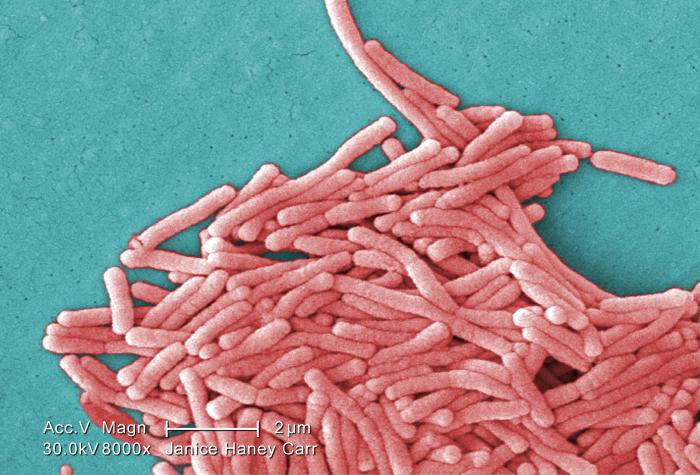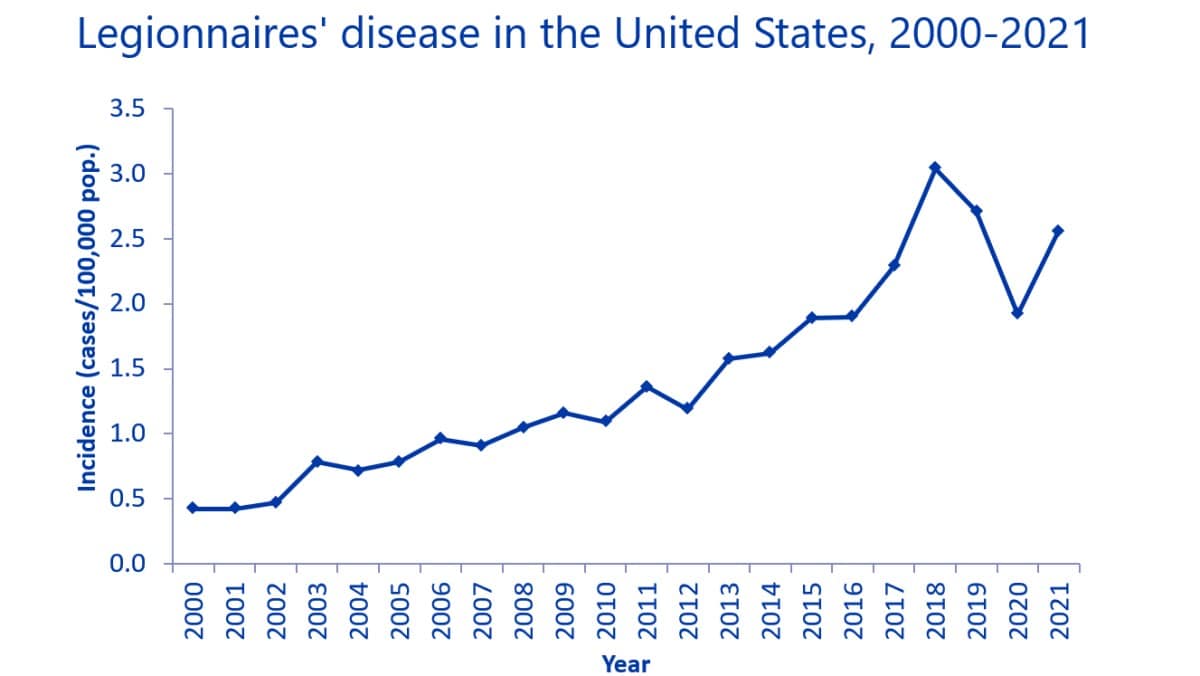
As the nation celebrated its bicentennial, news organizations flocked to Philadelphia after a mysterious outbreak occurred in a Philadelphia hotel where members of the Pennsylvania State American Legion were staying. About 200 Legionnaires were struck with what appeared to be severe cold symptoms, and 29 ultimately died. After months of panic and misinformation, in December 1976, the bacteria Legionella pneumophila was identified as the causative agent and determined to have spread from the hotel’s air conditioning system. The CDC first published the term Legionnaires’ Disease as the official name of the disease that had struck in Philadelphia.
Legionnaires’ Disease is a continuing public health threat:
- Fourteen cases of Legionnaires’ Disease in Grand Rapids, Minnesota, in 2023 and 2024. The source was determined to be the municipal water supply, which was not chlorinated because it drew water from groundwater sources, such as community wells.
- Twenty-four cases and two deaths from Legionnaires’ Disease in the Bronx, New York, in 2022. The source was found to be four cooling towers in the area.
- 136 cases and four deaths from Legionnaires’ Disease from people who attended the North Carolina Mountain State Fair in Western North Carolina in 2019. The source was determined to be hot tubs displayed in a building at the fair.
Legionnaires’ Disease causes over a thousand deaths a year in the U.S. but gets virtually no attention. While the media and the government constantly alert the public to potential dangers from foodborne illnesses, including Listeria and Salmonella, the same attention is not paid to ongoing threats from our nation’s water supplies. Foodborne illness kills an estimated 2,600 people in the U.S. each year, while waterborne disease kills three times as many people, approximately 6,630 people a year. Legionella bacteria is responsible for 37% of illnesses, 97% of hospitalizations, 98% of all deaths from these waterborne diseases, and 92% of disease outbreaks in public water systems. Why is so little attention paid to this clear and ongoing health threat?
What is Legionella?
 Legionella bacteria are typically found in fresh water and rarely cause illness. However, the bacteria may multiply and cause disease when small droplets of water containing the bacteria get into the air and people breathe them in. The most common places where Legionella can multiply and become a human health hazard are poorly maintained industrial water systems, cooling towers, or heating, ventilation, and air conditioning (HVAC) systems. Legionella can also be found in decorative fountains, hot tubs, and humidifiers.
Legionella bacteria are typically found in fresh water and rarely cause illness. However, the bacteria may multiply and cause disease when small droplets of water containing the bacteria get into the air and people breathe them in. The most common places where Legionella can multiply and become a human health hazard are poorly maintained industrial water systems, cooling towers, or heating, ventilation, and air conditioning (HVAC) systems. Legionella can also be found in decorative fountains, hot tubs, and humidifiers.
Legionella causes respiratory illness, Legionellosis, and is transmitted through the air, like influenza and COVID.
- Legionnaires’ Disease: A type of severe pneumonia with symptoms including cough, fever, headaches, muscle aches, and shortness of breath. It can progress to respiratory failure, organ failure, and death.
- Pontiac Fever, named for the town where it was first noted, is a mild self-limiting respiratory disease, usually lasting 2-5 days, and not fatal.
The people most susceptible to Legionnaires’ Disease are those 50 years or older, current or former smokers, people with chronic lung infections, or those who are immunocompromised. An estimated 8,000 – 18,000 people are hospitalized in the U.S. each year with Legionnaires’ Disease. While treatable with antibiotics, early diagnosis and treatment increases the chances of recovery; about 10% of patients with Legionnaires’ Disease will die from complications.
The number of cases has been increasing dramatically each year since 2000, with approximately 1,100 cases reported in 2000 and nearly 10,000 reported in 2018. Increased rates have been observed across all age groups and geographic areas, but likely underestimate the actual number of diseases because many people do not see healthcare providers when they have flu-like symptoms.
Legionnaires’ Disease has been nationally reportable since 1976, making it unlikely that the increase is due to increased reporting. A recent study examined the association between four environmental factors, temperature, precipitation, relative humidity, and UV radiation and Legionnaires’ Disease in cooling towers in New York State (between 1990 and 2020.) Although they found no association with these environmental factors, they found an association with declining sulfur dioxide pollution, which is the cause of “acid rain.” The authors concluded that declining sulfur dioxide pollution reduced the acidity of aerosols emitted from cooling towers, increasing the survival of Legionella in cooling tower droplets. This reminds us that even the most positive measures, such as reduced sulfur dioxide pollution, can have unintended consequences.
Prevention
The key to preventing Legionnaires’ Disease is minimizing the growth and transmission of Legionella. The CDC estimates that 9 in 10 outbreaks are preventable through building water management programs that:
- Ensure adequate disinfection
- Maintain devices to prevent sediment, scale, corrosion, and biofilm
- Maintain water temperature to limit Legionella growth
- Prevent water stagnation.
Each of these actions controls biofilms in water systems. In nonscientific terms, biofilm is the slime you see everywhere you find water, e.g., rocks on a mountain stream bed coated in slippery green slime. Biofilm found in plumbing systems provide the perfect breeding ground for Legionella and other microorganisms
Foodborne illnesses get the headlines, but Legionnaires’ Disease often goes unnoticed. Perhaps because Legionnaires’ Disease can be minimized by strong maintenance programs and infrastructure, it doesn’t have the cache that draws views and likes, resulting in insufficient awareness and motivation to do what is required to reduce the incidence of this highly preventable deadly disease.



